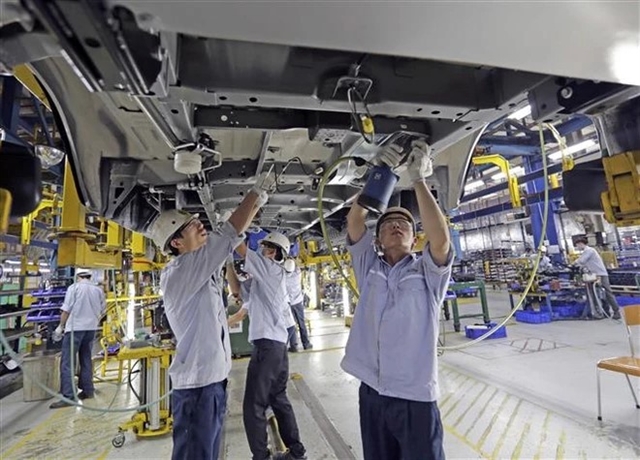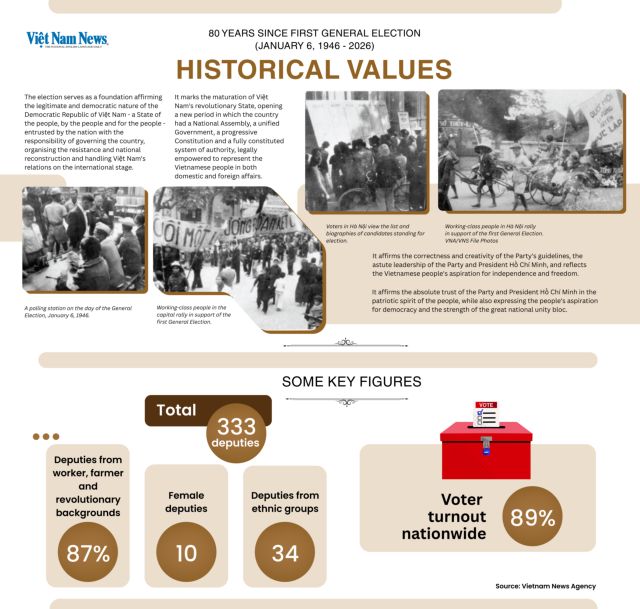 Economy
Economy

 |
| Workers at a car factory in the northern province of Hải Dương. — VNA/VNS Photo |
HÀ NỘI — Việt Nam continued to show improvement in economic activities but the Government should consider extending its economic support programme into the coming year, according to the latest report by the World Bank (WB).
The WB November report on the Southeast Asian economy showed a month-on-month increase in the industrial production index of 2.7 per cent, due to the increased production of key exports such as textiles (4.4 per cent) and electric equipment (7.9 per cent).
Monthly retail sales remained flat at -0.27 per cent m/m while retail sales growth averaged 7.5 per cent y/y between August and November, well below the pre-pandemic growth rates of about 12 per cent.
Overall performance of exports and imports of goods in November remained resilient amid recovering external demand, increasing by 6.7 per cent y/y and 5.1 per cent y/y, respectively. However, cumulative exports and imports for the 11 months in 2023 were still below the same period in 2022, falling by 5.9 per cent y/y and 10.7 per cent y/y, respectively, according to WB.
Consumer Price Index (CPI) inflation remain stable at 3.5 per cent y/y in November 2023, compared with 3.6 per cent y/y in October, well below the target inflation of 4.5 per cent.
Credit growth picked up slightly in November, growing at 10.3 per cent y/y, but remained well below the credit growth target set by the State Bank of Vietnam (SBV) at 14.5 per cent and pre-COVID levels at 12-15 per cent. This performance is due to the continued weakness in private investment and investor confidence, partly associated with uncertainty about the recovery of external demand as well as the sluggish real estate market.
Meanwhile, the government budget revenue collection during the first 11 months of 2023 fell by 6.2 per cent compared with the same period of 2022, due to the slowdown in economic activities. Eleven-month cumulative public expenditure, on the other hand, accelerated by 10.6 per cent y/y, reflecting the Government’s effort to support the slowing economy.
Public investment disbursement during the first 11 months grew by 36.3 per cent y/y, and November data continued to show improvement in economic activities. Following the trend since April 2023, the monthly seasonally adjusted Industrial Production Index (IIP) registered a growth rate of 2.7 per cent m/m in November, compared to 2.8 per cent m/m in October.
IIP grew 5.8 per cent y/y in November compared to 4.4 per cent y/y in October and was just above half of the pre-COVID19 level at 9.9 per cent average during 2018-19. The improvement is due to the increased production of key exports and products such as textiles by 4.4 per cent m/m, furniture by 9.9 per cent m/m, electronics by 2.3 per cent m/m, and electric equipment by 7.9 per cent m/m, said the report.
Manufacturing production for domestic consumption such as food and beverages also expanded by 2.0 per cent m/m and 5.2 per cent m/m, respectively. These expansions mirror relatively resilient domestic consumption and continued recovery in external demand.
However, prospects remain subdued with Việt Nam's PMI staying in contractionary territory in November at 47.3, the lowest since May 2023, compared with 49.6 and 49.7 for October and September, respectively. S&P Global PMI indicated that new orders fell in November, indicating still fragile demand conditions.
The WB recommended the Vietnamese Government extend the implementation of the 2022-23 economic support programme into next year to allow its planned investments to be fully implemented, supporting aggregate demand, according to the report.
WB warned amid the economic slowdown, financial sector vulnerabilities call for continued vigilance while efforts to restore confidence and promote the development of the real estate market will be key to supporting economic stability in the short term and economic growth in the long term. — VNS




